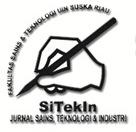Drying Cabinet Using UV Lamp
Abstract
Drying clothes is an activity carried out by the community. Uncertain weather, such as rain, causes the movement of drying clothes to be hampered. The uncertain weather factor caused by global warming causes the temperature to change, sometimes, it is hot, and sometimes it rains. This causes clothes not to dry entirely and causes damp garments frequently. In this scientific work, the researcher will make a device that functions as a drying cabinet which is equipped with a temperature sensor and drying time uses a DHT22 sensor temperature sensor and LCD, which works to display the drying process. and the time needed to dry the clothes equipped with a heater which functions as a heat source so that the clothes will dry to the maximum. Measurements were made at several test points in the circuit designed to get the most significant error percentage of 5.5% with an average error of 2 .40 %. The results of the design are carried out by the criteria used. From the results of the tests, the drying process using the tools designed has succeeded in drying clothes to the maximum and minimizing germs.
Full Text:
PDFReferences
W. Wang, “Post-drying decontamination of laver by dielectric barrier discharge plasma, UV radiation, ozonation, and hot air treatments,” LWT, vol. 176, 2023, doi: 10.1016/j.lwt.2023.114518.
X. Chen, “Application of combining ozone and UV-C sterilizations in the artificial drying of persimmon fruits,” LWT, vol. 134, 2020, doi: 10.1016/j.lwt.2020.110205.
D. Vernez, “Reusability of filtering facepiece respirators after decontamination through drying and germicidal UV irradiation,” BMJ Glob. Heal., vol. 5, no. 10, 2020, doi: 10.1136/bmjgh-2020-003110.
T. R. Braga, “Drying of mangoes (Mangifera indica L.) applying pulsed UV light as pretreatment,” Food Bioprod. Process., vol. 114, pp. 95–102, 2019, doi: 10.1016/j.fbp.2018.11.013.
S. Sumardiono, “Physicochemical and rheological properties of sago (metroxylonsagu) starch modified with lactic acid hydrolysis and UV rotary drying,” ASEAN J. Chem. Eng., vol. 18, no. 2, pp. 41–53, 2018, [Online]. Available: https://api.elsevier.com/content/abstract/scopus_id/85065242584
D. Sun, “Ultrafast fabrication of organohydrogels with UV-blocking, anti-freezing, anti-drying, and skin epidermal sensing properties using lignin-Cu2+plant catechol chemistry,” J. Mater. Chem. A, vol. 9, no. 25, pp. 14381–14391, 2021, doi: 10.1039/d1ta02139g.
C. Koga, “Stability of Trans-Resveratrol Encapsulated in a Protein Matrix Produced Using Spray Drying to UV Light Stress and Simulated Gastro-Intestinal Digestion,” J. Food Sci., vol. 81, no. 2, 2016, doi: 10.1111/1750-3841.13176.
M. M. Thu, “Effects of drying temperature on tomato-based thin film as self-powered UV photodetector,” Appl. Surf. Sci., vol. 445, pp. 186–196, 2018, doi: 10.1016/j.apsusc.2018.03.162.
F. Bigi, “Multivariate exploratory data analysis by PCA of the combined effect of film-forming composition, drying conditions, and UV-C irradiation on the functional properties of films based on chitosan and pectin,” LWT, vol. 137, 2021, doi: 10.1016/j.lwt.2020.110432.
P. K. Nair, “Prospects toward UV-blue filtered solar drying of agricultural farm produce using chemically deposited copper chalcogenide thin films on cellular polycarbonate,” Sol. Energy, vol. 203, pp. 123–135, 2020, doi: 10.1016/j.solener.2020.04.012.
C. Moon, “Intense Pulsed Light Annealing Process of Indium-Gallium-Zinc-Oxide Semiconductors via Flash White Light Combined with Deep-UV and Near-Infrared Drying for High-Performance Thin-Film Transistors,” ACS Appl. Mater. Interfaces, vol. 11, no. 14, pp. 13380–13388, 2019, doi: 10.1021/acsami.8b22458.
G. Cardwell, “Effect of air-drying on the generation of vitamin D2 and 25-hydroxyvitamin D2 by pulsed UV irradiation in button mushroom (Agaricus bisporus),” J. Food Compos. Anal., vol. 115, 2023, doi: 10.1016/j.jfca.2022.105034.
A. Forouzanfar, “Influence of uv-b pretreatments on kinetics of convective hot air drying and physical parameters of mushrooms (Agaricus bisporus),” Agric., vol. 10, no. 9, pp. 1–10, 2020, doi: 10.3390/agriculture10090371.
Q. Jiang, “UV induced conversion during drying of ergosterol to vitamin D in various mushrooms: Effect of different drying conditions,” Trends in Food Science and Technology, vol. 105. pp. 200–210, 2020. doi: 10.1016/j.tifs.2020.09.011.
N. Nölle, “Vitamin D2 enrichment in mushrooms by natural or artificial UV-light during drying,” LWT, vol. 85, pp. 400–404, 2017, doi: 10.1016/j.lwt.2016.11.072.
H. Hwang, “All-photonic drying and sintering process via flash white light combined with deep-UV and near-infrared irradiation for highly conductive copper nano-ink,” Sci. Rep., vol. 6, 2016, doi: 10.1038/srep19696.
J. Huang, “Lignin nanorods reinforced nanocomposite hydrogels with UV-shielding, anti-freezing and anti-drying applications,” Ind. Crops Prod., vol. 187, 2022, doi: 10.1016/j.indcrop.2022.115324.
DOI: http://dx.doi.org/10.24014/sitekin.v20i2.22176
Refbacks
- There are currently no refbacks.
Copyright (c) 2023 SITEKIN: Jurnal Sains, Teknologi dan Industri
 | Editorial Address: FAKULTAS SAINS DAN TEKNOLOGI UIN SULTAN SYARIF KASIM RIAU Kampus Raja Ali Haji Gedung Fakultas Sains & Teknologi UIN Suska Riau Jl.H.R.Soebrantas No.155 KM 18 Simpang Baru Panam, Pekanbaru 28293 © 2023 SITEKIN, ISSN 2407-0939 |
SITEKIN Journal Indexing:
Google Scholar | Garuda | Moraref | IndexCopernicus | SINTA

SITEKIN by http://ejournal.uin-suska.ac.id/index.php

.png)





